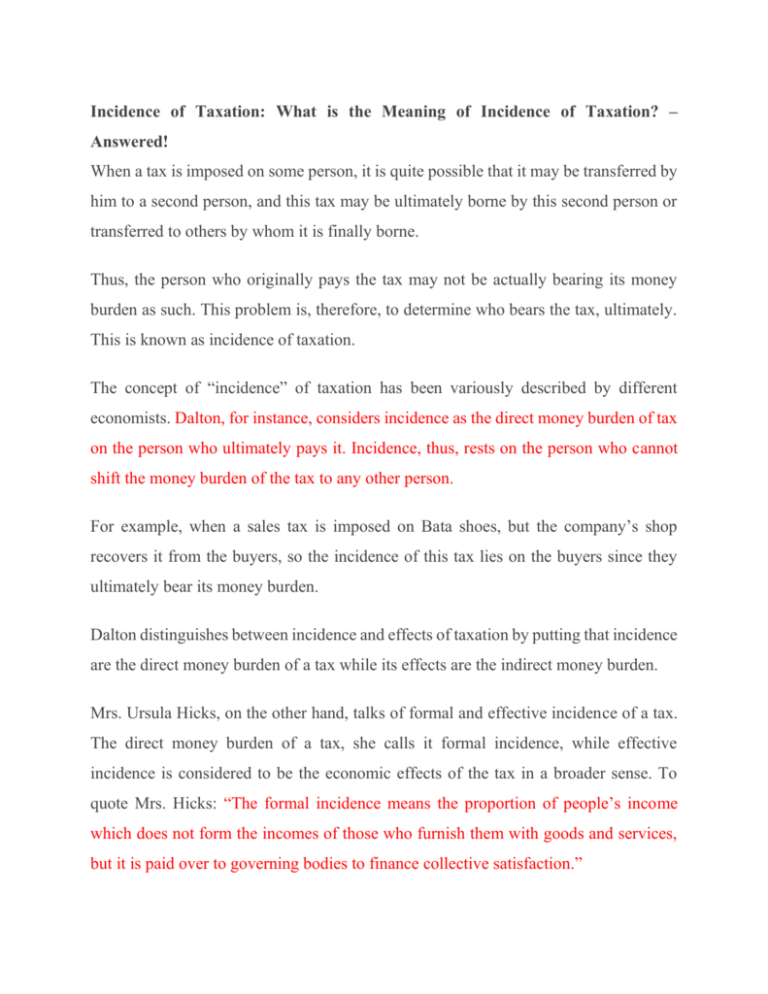Incidence of Taxation
advertisement

Incidence of Taxation: What is the Meaning of Incidence of Taxation? – Answered! When a tax is imposed on some person, it is quite possible that it may be transferred by him to a second person, and this tax may be ultimately borne by this second person or transferred to others by whom it is finally borne. Thus, the person who originally pays the tax may not be actually bearing its money burden as such. This problem is, therefore, to determine who bears the tax, ultimately. This is known as incidence of taxation. The concept of “incidence” of taxation has been variously described by different economists. Dalton, for instance, considers incidence as the direct money burden of tax on the person who ultimately pays it. Incidence, thus, rests on the person who cannot shift the money burden of the tax to any other person. For example, when a sales tax is imposed on Bata shoes, but the company’s shop recovers it from the buyers, so the incidence of this tax lies on the buyers since they ultimately bear its money burden. Dalton distinguishes between incidence and effects of taxation by putting that incidence are the direct money burden of a tax while its effects are the indirect money burden. Mrs. Ursula Hicks, on the other hand, talks of formal and effective incidence of a tax. The direct money burden of a tax, she calls it formal incidence, while effective incidence is considered to be the economic effects of the tax in a broader sense. To quote Mrs. Hicks: “The formal incidence means the proportion of people’s income which does not form the incomes of those who furnish them with goods and services, but it is paid over to governing bodies to finance collective satisfaction.” The 'incidence' of a tax refers to who bears the burden of the tax. We can distinguish between two types of tax incidence: formal incidence, meaning who is legally obliged to pay the tax, and effective incidence, meaning who actually bears the economic burden of the tax. The formal incidence and effective incidence of a tax will often be different owing to the potential for the tax burden to be passed on through the operation of the price mechanism. As will be shown below, the extent to which the tax burden can be shifted depends on a number of different factors. According to Mrs. Hicks, the calculation of formal incidence is useful in assessing the question of redistribution of income through taxation. It may also be helpful in economic planning. However, the exact reaction of tax payers to a change in tax or the economic repercussions of a tax cannot be directly ascertained by a mere estimate of the formal incidence. For this, we have to resort to the concept of “effective incidence”. Musgrave, however, speaks of specific tax incidence and differential tax incidence of a budget. Specific tax incidence is one when the pattern of distribution changes due to the imposition of a new tax or by changing the rates of existing taxation, keeping public expenditure and other budgetary phenomena unchanged. Differential tax incidence refers to change in the distribution pattern in the economy caused by substituting one tax for another, total tax revenue being unchanged. In modern economic literature, it has been observed that “the traditional concept of incidence has been criticised in recent years and new ways of looking at the question have been suggested. It is pointed out that taxation by itself does not cause a reduction in real income available for private use; it is public expenditure that absorbs real resources. Taxes may be increased or reduced for any number of reasons without changing the level of real public expenditure. Taxation only changes the distribution of income and the incidence of taxation should accordingly be defined as the change in the distribution of real income available for private use.” Thus, the concept of differential incidence is much appreciated by modern economists, as it relates to a change in the tax system.







